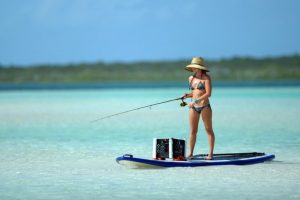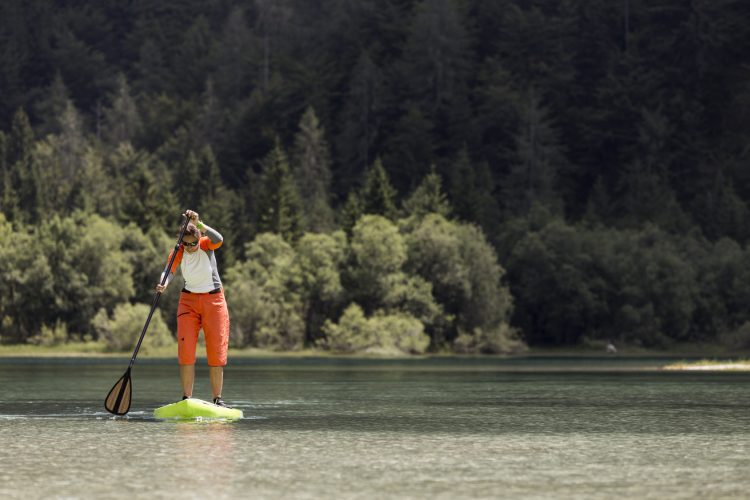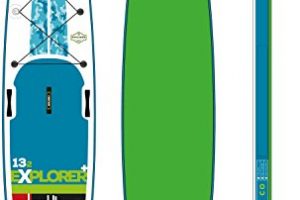 You’ve shelled out for a great paddle board, but to keep it great you need the right paddle board bag. The average paddler makes 7 outings a year. Without the right bag, each outing risks damaging your board.
You’ve shelled out for a great paddle board, but to keep it great you need the right paddle board bag. The average paddler makes 7 outings a year. Without the right bag, each outing risks damaging your board.
Not all bags are created equal. If you go with the wrong one, it could lead to damage for your board and costly repairs down the road.
In this post, we’ll get into the nitty gritty of paddle board bags. We’ll explain what these bags should be used for and when. Plus, we’ll show you how to pick the right bag for your paddle board style.
Read on to get the low-down on paddle board bags and store your board in style.
What Are Paddle Board Bags For?
It may seem like a bit of an obvious question. Of course, a paddle board bag is for holding your paddle board.
But it isn’t actually that simple. A paddle board bag isn’t an all-encompassing storage solution for your board.
For the most part, these bags are only meant to be used for transporting your bag from your home to the shore. They are meant to protect your board from damage while you are hauling it around.
This damage can include anything from scratches and dings to serious damage to the board’s structure.
A paddle board bag is not meant for storing your board (except for a few exceptional bags we will discuss later). Keeping your board in a bag for long periods of time can absolutely destroy your board.
These bags seal pretty tight. This means that any moisture that was still on your board when you bagged it has nowhere to escape. Instead, it turns up the humidity in the bag and, over time, causes water damage to your board. Mold, blistering, and cracking caused by long time storage in a paddle board bag can make your board unusable.
So basically, only use a paddle board bag to transport your board. If you want a storage solution, look for a storage rack or shed.
Choosing the Right Paddle Board Bag for Your Board
There is no single paddle board bag that is the right choice for everyone. Otherwise, we could end this article right here!
In reality, different bags have features that will suit different types of boards and paddlers. You should pay attention to the type of paddle board that you have when you are choosing a bag for it.
Board Size and Width
When buying a bag, you need to completely understand your board’s dimensions. Flat water and yoga boards tend to be wider than touring, racing, or surf stand up paddle boards. This means you’ll need to look for a wider bag.
You need a bag that will fit your board without straining or stretching the zipper. If the bag is strained, it won’t provide the best possible protection for your board. At the same time, extra room in the bag leaves room for it to slide around, possibly becoming damaged even inside the bag.
A perfect fit is essential to make sure your paddle board bag is doing its job.
When shopping for a paddle board bag, you can’t exactly bring your board to the store to try out bags. Write down your board’s dimensions, model type, and brand when you go shopping.
Inflatable Stand Up Board Transport
Inflatable stand up boards use a completely different type of bag since they are made for easy storage and transport. They generally roll up, making them very easy to carry.
For these bags, you can often purchase a backpack-type bag. This makes carrying the board from your home to the beach a breeze. Backpacks distribute the weight more evenly across your body, reducing the chance for damage to your back.
Able to be carried easily, not weighing too much, and rolling up quite small for easy storage are only some of the reasons that inflatable boards are a great choice. They are actually the type of stand up paddle board growing the fastest in popularity.
Just don’t be tempted to use any old backpack to carry your inflatable board. It won’t provide any of the same protections as a proper inflatable board bag.
Taking Fins into Consideration
Your board’s fins will also affect the bag you buy.
While inflatable boards have removable fins that can slide right into the transport bag, other board’s fins can create a bit more of an issue.
Besides being long and wide enough to fit the board itself, any bag you buy needs to have the right fin slots for your board. Whether you have a large single fin or multiple smaller ones, the bag needs to fit them.
This will mean you don’t have to remove your fin every time you are bagging your board. This keeps your bag safe without extra hassle.
Finding The Best Foam Lining
Now that you’ve got the size and shape of your bag sorted out, the next most important feature of a bag is the foam.
The foam lining of a bag is what really protects your paddle board, insulating it from any bumps while you drive or carry it. At the same time, extra foam adds extra weight, making the bag more cumbersome to carry.
A highly protective bag will have about 10mm (or 1/4 inches) of protective foam. This foam layer will likely be on both sides of the bag, so your board is completely enclosed.
This much foam can make the bag weigh around ten pounds. This is extra weight that you will need to be able to carry in addition to the weight of your board. If you have to carry your board long distances from your home to your car, or the car to the shore, you may want to consider a lighter option.
Bags with less foam provide less protection but tend to be lighter. They also tend to cost less. So, when you are choosing your paddle board bag, you need to balance your needs for protection for your board with the weight and cost.
Choose a Reflective Outer Lining
The color of your paddle board bag actually makes a big difference beyond personal taste. It actually can change how much protection that your bag provides.
Many paddle board bags have a shiny silver outer lining. Whether or not this is your favorite style, it is the best color choice when it comes to protecting your board.
This is because the shiny silver reflects light and heat. It acts as what is called a radiant barrier and keeps your bag and board cool not just by stopping heat, but actually reflecting it away. This makes sure that your board does not become too hot if it is left out in the sun on the beach.
Though paddle boards are most commonly used on beautiful summer days, sunshine and heat can cause serious damage. Both the surface and the core of your board are at risk from heat damage. The outer coating can crack and become damaged. Heat can cause pressure to build up in the core, causing damage and even cracking.
This is also why you shouldn’t just wrap your board in insulating foam, blankets, or bubble wrap instead of a bag. These will just increase the chance for heat damage.
But you don’t need to stick to cold weather boarding when you’ve got a bag to protect your board. Reflective silver on your bag’s outer lining will help keep the heat in the bag from growing too extreme.
Even with a reflective lining, you still shouldn’t leave your bag in direct sunlight for too long. Try to keep it shaded whenever you can.
Other Outer Lining Options
If you’re not going with a silver reflective bag, the color is still important. Light colors, especially white, will do a much better job of keeping your bag cool.
Dark colored bags will do the opposite, putting your board in a damaging sauna. An all black is the most dangerous color choice.
Other Useful Bag Features
We’ve gone through the main things you need to consider when choosing a new paddle board bag. There are a couple more useful features to look for in a bag. We’ll run through these next.
Ventilation
A bag with vents built in can help reduce the chances of water damage when your board is in the bag. This is especially important if your board is in the bag for longer periods of time.
Ventilation in a bag can come in a couple different forms. Small air vents, mesh, or breathable fabrics all allow more airflow in the bag. This means that humidity won’t build up, and there will be less chance of damage or mold.
Comfort in Carrying
The straps the bag comes with can make a big difference to your comfort when you are carrying your board.
Padded straps will make carrying your board comfortable over long distances. Shoulder straps are a great choice, as they allow you to distribute the weight across your back instead of just using your arms.
Concessions for Extra Gear
Some bags also keep in mind the other gear that you need when you are paddle boarding.
Certain bags come with attachments for carrying your paddle or pockets to store your fins. Or, they have pockets for extra gear, meaning you don’t have to try to lug around a backpack in addition to your board.
Or, for inflatable boards, some bags come with storage space for your pump.
Bagging your Paddle for Extra Protection
In addition to bags to protect your board, you can also keep your paddle safe.
While your paddle is not as prone to damage as a board, or as expensive to repair or replace, a bag can offer some additional protection. It will keep your paddle safe from scratches and dents. These bags are also very light, so it won’t add carry weight.
A Water-Safe Zipper
Look for bags that have a non-corrosive zipper. As these bags are designed to be used in wet, sandy locations, most bags should have this automatically.
This will ensure that you can open and close your bag with ease.
Keeping Your Board Safe in a Paddle Board Bag
Once you’ve chosen the right bag for your board, there are a few things to keep in mind. Following the proper maintenance and care will keep your board from being damaged when using a bag.
Most importantly, you should never put your board in the bag while it is still wet. Even if you have a ventilated bag, you will be putting your board at risk for serious water damage.
While the boards are made to be used in water, it doesn’t mean that they are waterproof. Sitting in a humid bag, especially with water pooled at the bottom will cause your board to get moldy or even crack.
Second, a bag is meant to provide extra protection, but that doesn’t mean it can withstand anything. You should still be careful carrying your board. The bag won’t protect it against heavy force.
Plus, if you’ve got your fin in the bag’s fin slot, it is still susceptible to scrapes and dents.
Finally, keep your bagged board out of the elements. Try to keep it in the shade, out of direct sunlight whenever possible. Never let it get caught in the rain.
With these tips, you can keep your board undamaged and lasting for years and years.
Wrapping Up
With these tips, you can find the right bag for your paddle board. No matter what type of board you have, you can keep it safe from scratches, dents, and major force damage.
You need a bag that will fit your board’s dimensions like a glove. The amount of foam will affect how much protection the bag provides, but also changes the weight and cost.
A reflective or light-coloured outer lining will keep your board safe from heat damage. Other useful features like gear storage pockets and padded handles and straps can make a bag even more effective for your outings.
Do you have more questions about finding the right paddle board bag, or just want to talk shop? Reach out to us today and we’d be happy to help get you out on the water!









